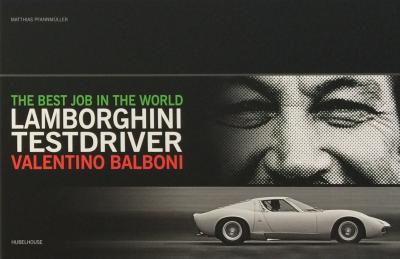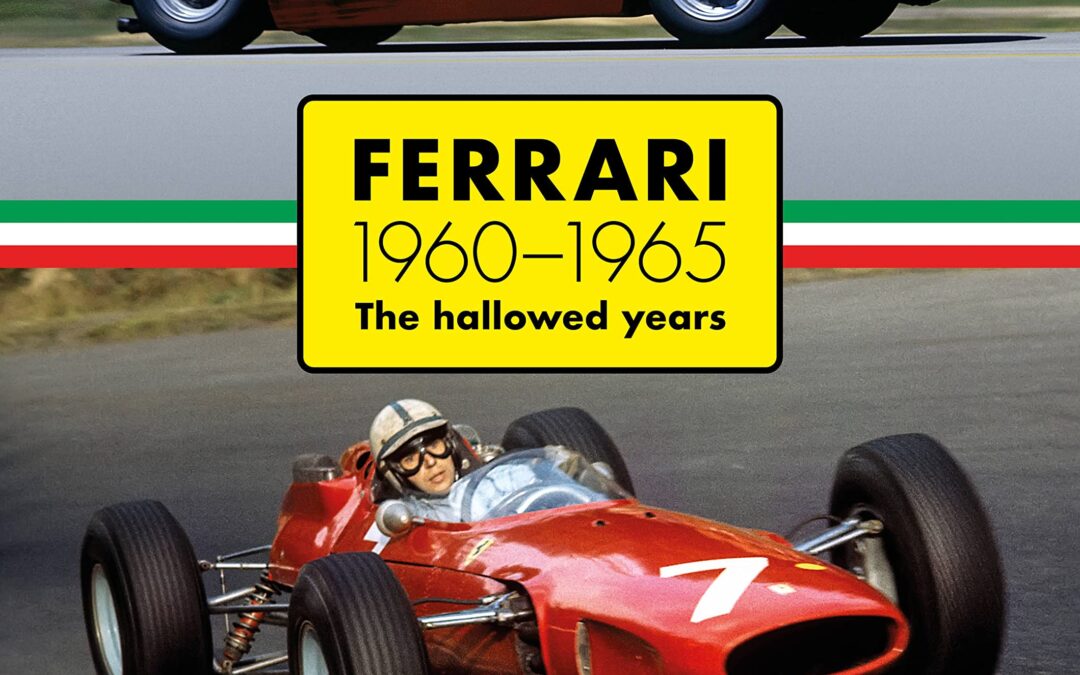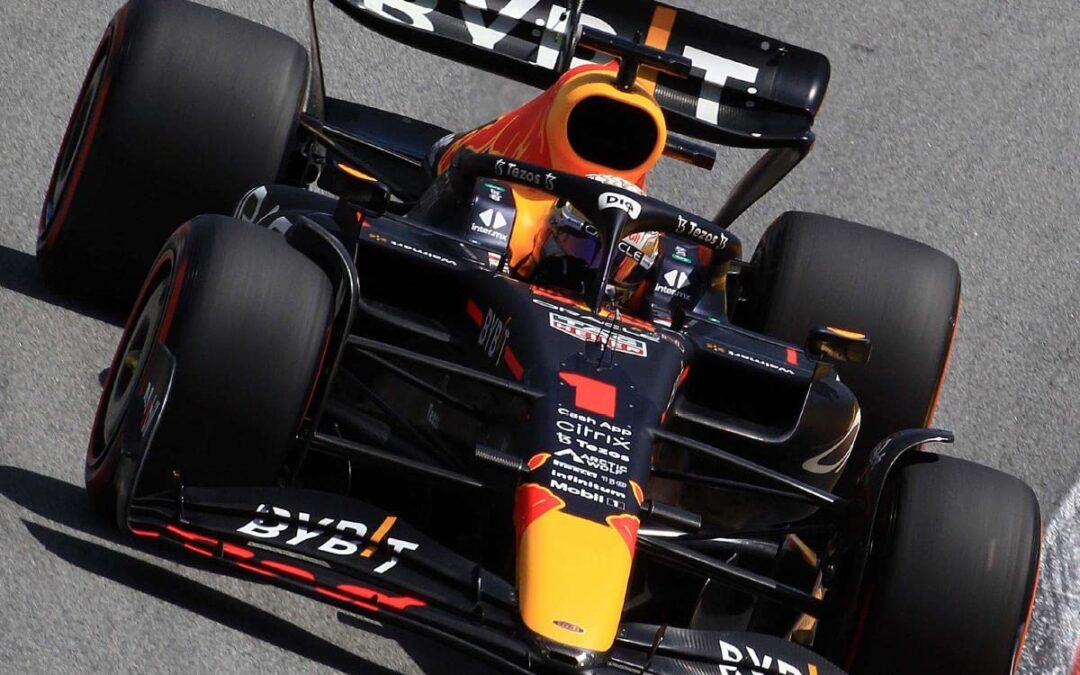
72nd YEAR OF PUBLICATION
Another record-breaking 22 Grand Prix season saw Red Bull Racing and Ferrari go head-to-head with some spectacular races and epic drives from all four drivers, each one winning one or more races. Mercedes with Lewis Hamilton and new recruit George Russell struggled for most of the season with aero and relentless porpoising until mid-way through the season when their performances improved and some notable qualifying and race results appeared, but far too late to challenge for the top spot.
There were some flashes of brilliance from the midpack consisting of Alpine, McLaren, Alpha Tauri, and Alfa Romeo, but Aston Martin, Haas, and Williams continued their struggle for consistency.
Authors Tony Dodgins and Maurice Hamilton, combining 80 years of F1 expertise, examine each round in depth. Full race reports are backed by detailed results, including lap charts and tire strategies.
The nuances of F1’s designs and development are analyzed team by team by the much-respected Mark Hughes, enhanced by Adrian Dean’s handsome F1 car illustrations.
Motor racing’s other major categories are also fully covered: Toyota’s WEC and Le Mans sports car successes; the closely fought Formula 2 and Formula 3 championships, featuring emerging young talent from around all continents of the world; and the tightly fought Formula E series for electric powered single seaters.
AUTOCOURSE includes all the hectic action from the top Touring Car series – the World Touring Car Cup and the British Touring Car Championships as well as the DTM Series running GT cars from Audi, Mercedes, BMW and Ferrari.
From America, Gordon Kirby recounts a thrilling Indycar series, featuring a mix of youthful talent such as Alex Palou and Pato O’Ward, both of whom vying to overturn the established veterans who have dominated proceedings over the past decade. The ever-popular NASCAR stock car series ran from February to November with barely a weekend’s break, to feature more than forty races before the final championship play-off round at Phoenix, Arizona.
In a single essential volume, AUTOCOURSE provides the most comprehensive record of world motor sport, complete with full results not found anywhere in a single volume.
It is required reading for all motor sport fans worldwide.

Relive all the most important moments of the last two WorldSBK seasons in the 2020/2021 Official Yearbook, which includes the analysis of every single round and of all the different classes of the Championship.
While the 2020 season saw yet another success for the Rea-Kawasaki duo which, among the manufacturers, prevailed by only one point over Ducati, the 2021 World Championship lived on the close fight between the “usual” Rea and Toprak Razgatlioglu with the Yamaha. But the World Superbike 2020-2021: The Official Book, in addition to the sports news, also reviews the technical aspects of the motorcycles protagonists of the World Championship, dedicating a specific chapter to the World Champion and not neglecting statistics and records, all using a photographic repertoire of extraordinary charm and suggestion.
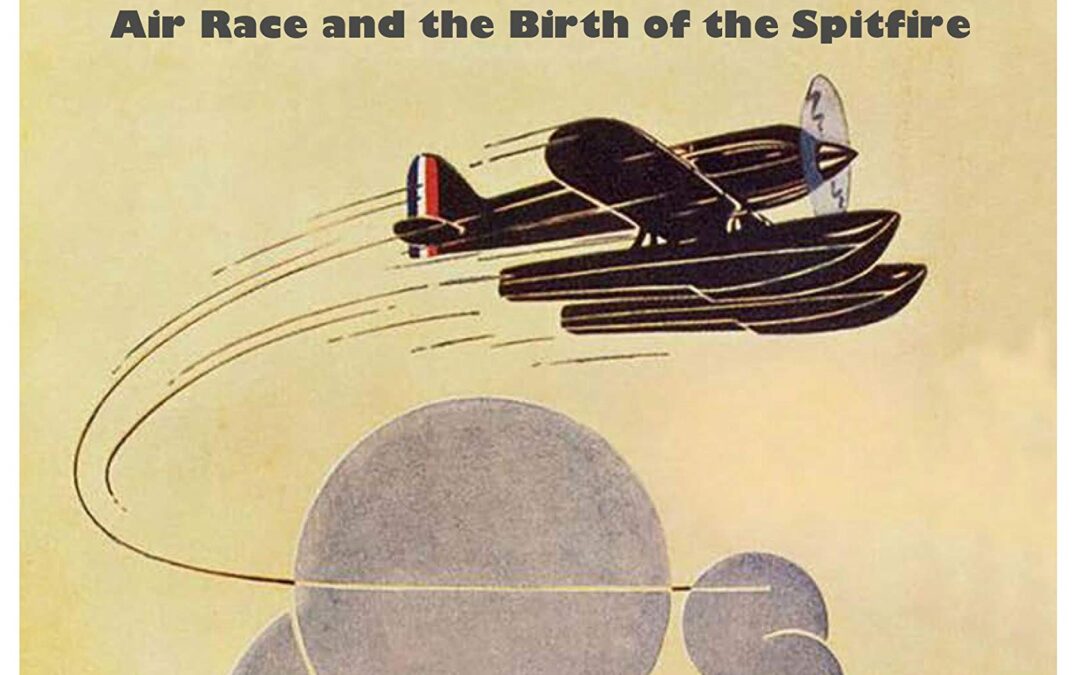
Announced in 1912, the Schneider Trophy was a series of glamorous air contests, popularly known as races, that captivated both sides of the Atlantic. While there were many other aviation competitions, the Schneider proved to be, after a rocky start, by far the most memorable attracting a hugely popular and glamorous following whether Trophy races were held in Monaco, the Venice Lido, the Solent or Chesapeake Bay.
The Schneider Trophy was a focus not just of remarkable aircraft, derring-do pilots and swooning public attention, but also of fierce rivalries between the competitors: Britain, France, Italy and the United States. It gripped the imaginations of pioneering manufacturers and two of the world’s finest aircraft designers - Reginald Mitchell and Mario Castoldi – who worked feverishly hard to outdo one another. Perhaps inevitably, the dynamism of rival engineering and politics led to the most potent military fighters of World War Two with Reginald Mitchell’s record-breaking Supermarine seaplanes morphing, one way or another, into the Spitfire.
Wings Over Water not only tells the story of the Schneider Trophy afresh but also examines the backdrop and legacy of these legendary air races, which became a driver and celebration of speed and engineering prowess for both sea and ground-based aircraft. It is an exhilarating tale of raw adventure, public excitement, engineering genius and the fortunes of flying boats and seaplanes.
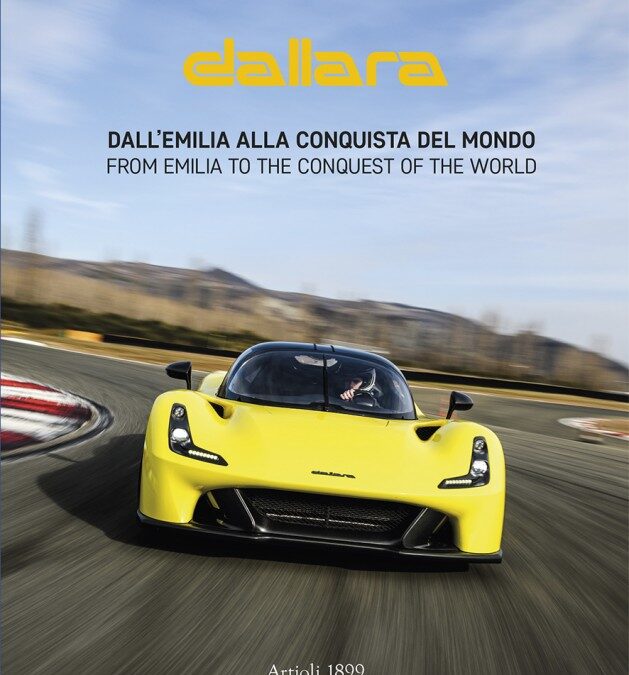
Before he was thirty, the engineer Giampaolo Dallara designed the Lamborghini Miura, a supercar that came from another planet, and one that caused its entire global competition to age overnight. More recently, his cars have won nineteen editions of the Indianapolis 500, historically the most important race in the world. And then another surprise, the presentation of the Dallara Stradale, a fascinating 400 hp supercar produced in series in the multi-faceted factory of Varano de’ Melegari, in the province of Parma.
These three commitments alone would be sufficient for a vast book on the activity of Giampaolo Dallara, who however has never ceased to broaden his own interests, based on the passion for motor sport and the evolution of technology. In 320 pages we describe how this extraordinary character, of great technical ability and of equally remarkable human depth, has evolved from his first job in Ferrari’s racing department, to the growth that led him to become the most important manufacturer of racing cars in the world, starting from a small ‘factory’, which over the years has been transformed into a company with over 700 employees.
This miracle has come about due to the undoubted technical ability of the engineer from Varano, but also due to his personality, an exceptional mix of pragmatism and simplicity, which can be summed up in the motto of the company created in 1972: ‘The continuous search for excellence’.
A commitment that has allowed him to add to his ‘core’ business activity, the design of road and racing cars for some of the world’s top companies: Ferrari, Alfa Romeo, Bugatti, Maserati, Audi, Toyota, Honda and KTM.
But Dallara has never ceased to amaze: in the autumn of 2018 he inaugurated the ‘Dallara Academy’: a commitment desired and financed by the engineer himself, materialized in a new, modern structure that, together with the vast ‘museum’ with all the Dallara cars ever built, includes classrooms for educational purposes for middle and high school students, up to a Master’s degree in ‘Racing Car Design’.
A great engineer, a great Italian and a perfect Emilian!
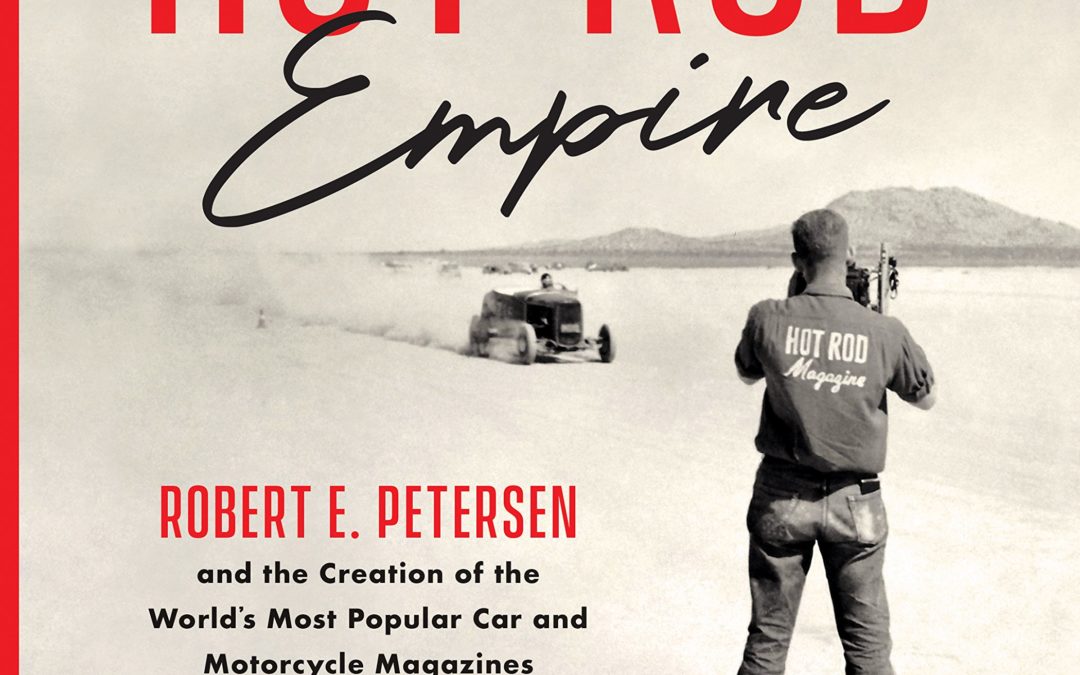
Hot Rod Empire details Robert E. Petersen’s creation of Hot Rod Magazine in the 1940s and the Petersen Publishing empire that grew to the mainstream juggernaut we know today.
The end of World War II marked the release of pent-up war-years energy and the desire to live. For many this meant indulging in long-denied purchases, like a new car. For another group, including young vets, it meant a return to car building and racing. Money, exciting new cars, and speed parts all flowed freely in post-war America.
Robert Petersen, a young SoCal-based photographer and Army Air Corps vet, noted the rapidly growing hot rod scene in and around Los Angeles. His first move was to organize the Los Angeles Hot Rod Exhibition in 1948. His second, and brilliant, move was to launch at the same event the first edition of Hot Rod magazine. From this launch pad, Petersen Publishing Company would grow to become the most influential enthusiast publisher in America.
Petersen’s magazines were rallying points for all aspects of the car, truck, and motorcycle hobbies, well as nurturing and promoting all aspects from car building to racing to show events. Hot Rod, Motor Trend, Car Craft, Motorcyclist, Off-Road and Four Wheel Drive and some 75 other enthusiast titles dominated magazine racks and provided substantial influence over transportation and numerous other hobbies.
Hot Rod Empire celebrates the birth and explosive growth of the transportation hobby under Petersen’s watch.

In May 1935, twenty-two-year-old Max Reisch and nineteen-year-old Helmuth Hahmann set out in a small motor car to find a land route from India to China. Their journey across Asia took them from Haifa to Tokyo.
In this lively account, the author regales us with one story after another, struck with wonder or struggling against disaster in countries which deeply concern us today: Iraq with its oilfields, ancient Iran in the throes of modernization, proud Afghanistan, and British India with its stunning variety of civilization.
Before the building of the Burma Road, driving from India to southern China meant sinking over the axles in mud on forest tracks and crossing torrents on rickety ferryboats. It also meant encounters with strange and fascinating peoples and places.
Originally written by Max Reisch in German, this brand new English translation of An Incredible Journey by Alison Falls captures all the excitement of the journey, and features fascinating historical photos of the journey from the Reisch archives.
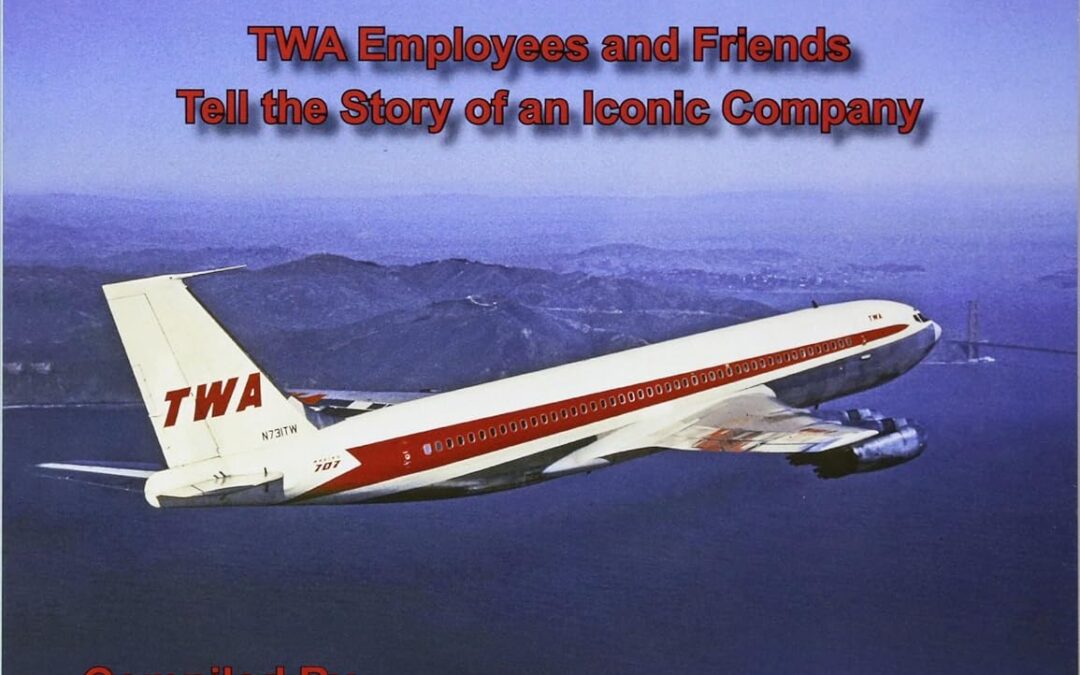
TRANS WORLD AIRLINES – A Book of Memories is a history of TWA offered in a different and most unique format… through the eyewitness experiences of its flight crews and ground workers, as well as friends of the company who share their reminiscences.
TWA was a pioneer and an important domestic and international airline that played prominently in developing commercial aviation. This book introduces the founders of the airline and some of the early pilots, flight attendants and mechanics who set the standard. We also glimpse inside to the legendary and colorful Howard Hughes, who shaped the airline and campaigned for the Lockheed Constellation. We also learn about Carl Icahn and his controversial leadership of the airline.
Jon Proctor, who devoted twenty-seven years of his professional life to TWA, contributed several stories, including a description of TWA’s famous Royal Ambassador Service and the Grand Canyon crash. Jon has also contributed many of the beautiful photographs of TWA aircraft that grace the pages of this book.
Another TWA veteran, George Hamlin, also contributed many images, as well as stories about the iconic Flight Center at New York International Airport. Other contributions detail many of the VIPs who traveled on TWA, including White House press charters for Presidents Johnson and Nixon; plus Hollywood celebrities, and legendary figures such as Bing Crosby and David Letterman.
These are stories from the heart, from employees who dedicated their entire professional careers to the airline, involved personally with the incredible achievements that made TWA the carrier it was. The people of TWA, numbering in the tens of thousands, literally spanned the globe over the years. We invite readers to enjoy these stories, which revisit an era that will never be replicated.
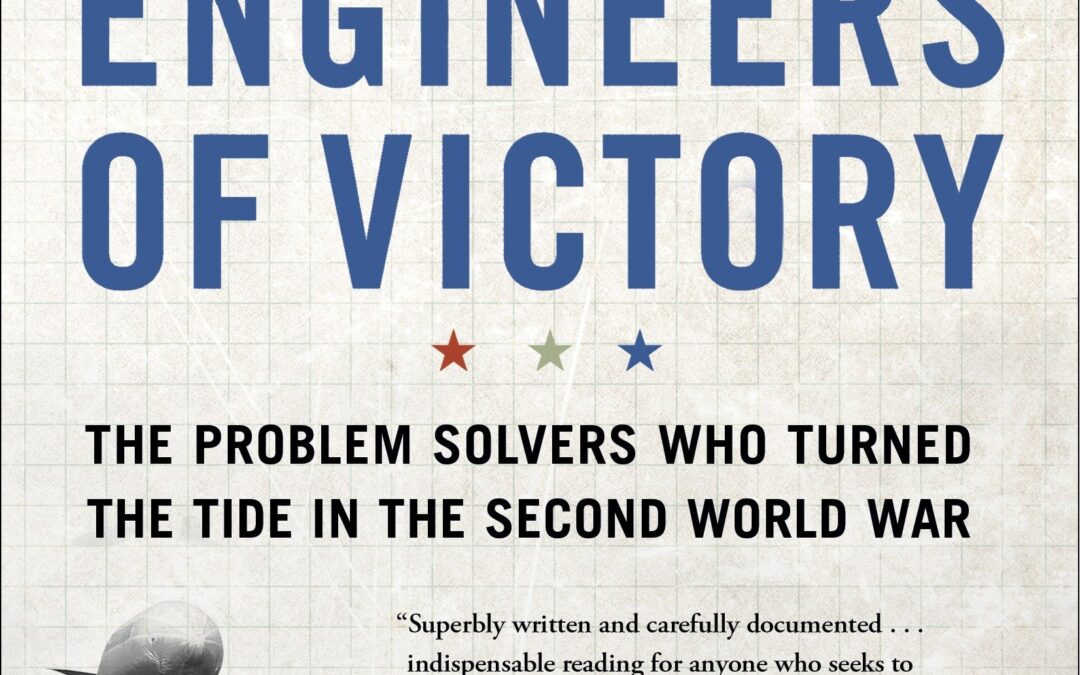
Paul Kennedy, award-winning author of The Rise and Fall of the Great Powers and one of today’s most renowned historians, now provides a new and unique look at how World War II was won. Engineers of Victory is a fascinating nuts-and-bolts account of the strategic factors that led to Allied victory. Kennedy reveals how the leaders’ grand strategy was carried out by the ordinary soldiers, scientists, engineers, and businessmen responsible for realizing their commanders’ visions of success.
In January 1943, FDR and Churchill convened in Casablanca and established the Allied objectives for the war: to defeat the Nazi blitzkrieg; to control the Atlantic sea lanes and the air over western and central Europe; to take the fight to the European mainland; and to end Japan’s imperialism. Astonishingly, a little over a year later, these ambitious goals had nearly all been accomplished. With riveting, tactical detail, Engineers of Victory reveals how.
Kennedy recounts the inside stories of the invention of the cavity magnetron, a miniature radar “as small as a soup plate,” and the Hedgehog, a multi-headed grenade launcher that allowed the Allies to overcome the threat to their convoys crossing the Atlantic; the critical decision by engineers to install a super-charged Rolls-Royce engine in the P-51 Mustang, creating a fighter plane more powerful than the Luftwaffe’s; and the innovative use of pontoon bridges (made from rafts strung together) to help Russian troops cross rivers and elude the Nazi blitzkrieg. He takes readers behind the scenes, unveiling exactly how thousands of individual Allied planes and fighting ships were choreographed to collectively pull off the invasion of Normandy, and illuminating how crew chiefs perfected the high-flying and inaccessible B-29 Superfortress that would drop the atomic bombs on Japan.
The story of World War II is often told as a grand narrative, as if it were fought by supermen or decided by fate. Here Kennedy uncovers the real heroes of the war, highlighting for the first time the creative strategies, tactics, and organizational decisions that made the lofty Allied objectives into a successful reality. In an even more significant way, Engineers of Victory has another claim to our attention, for it restores “the middle level of war” to its rightful place in history.
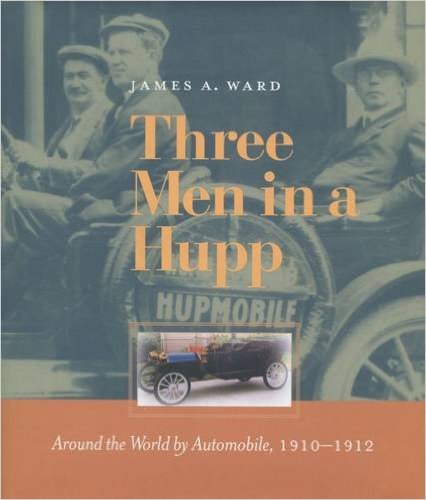
In late 1910, three American adventurers set off on a remarkable around-the-world journey by automobile. Sponsored by the Hupp Motor Car Corporation, the trip was intended to publicize the durability of the Hupmobile and help stimulate export sales.
The car was first driven from Detroit to San Francisco—a very difficult journey in its own right in 1910. From San Francisco, the car and its drivers took a steamship to Hawaii, and from there to Fiji, Australia, New Zealand, and Tasmania, unloading and touring at each port of call. The men and their machine spent the next five weeks attempting to drive through the Philippines, and then pushed on to Japan and China, where they managed to stay one step ahead of the Chinese revolution. They then drove across India, and from there, sailed to Egypt, brining the first automobile ever to be seen in that country. Next, the Hupmobilists sailed to Italy. In Rome, the adventurers met Pope Pius X, and then drove north to Germany and France. They crossed the English Channel to Folkstone, toured England, and then ferried from Liverpool to Ireland. They returned to New York in time for the 1912 auto show.
In the end, the Hupmobile was driven 41,000 miles and transported by steamship another 28,000. A new world was dawning, both for transportation and for American business enterprise.
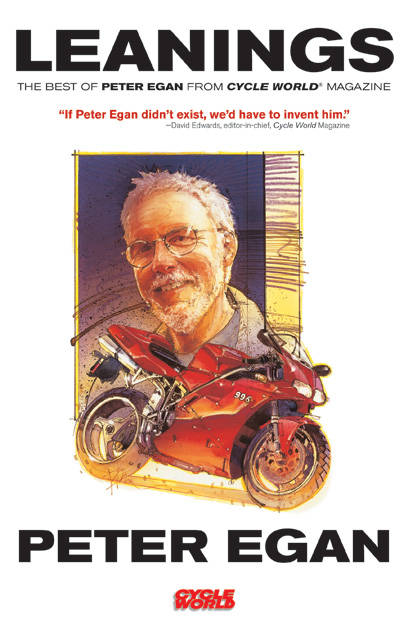
“Since his work first graced the pages of Cycle World magazine in 1977, Peter Egan has taken his readers on one unforgettable adventure after another. Whether riding along the Mississippi River to New Orleans for a tin of chicory coffee, or flying to Japan to test-ride new Yamahas, Egan’s insight and gift with words makes every journey a unique and fascinating experience.
Available in paperback for the first time, Leanings is a collection of Egan’s favorite feature articles and columns from Cycle World magazine. Included among the 21 feature articles are Egan’s first feature for the magazine, a story about he and his wife’s cross-country trip on a British twin, his journey on abandoned Route 66, a history of the motorcycle jacket, and his visit to the fabled Tourist Trophy race on the Isle of Man. A selection of 27 columns are also reproduced here, covering a wide range of subjects, from the nearly lost art of the kick start, how to survive not being able to ride for an entire Wisconsin winter, and a look back at the motorcycle crash that nearly killed the great Bob Dylan. For added perspective, each feature article is preceded by commentary from the author. This is an unforgettable collection of the works of a master writer, whose simple adventures of life remind us all why we love to ride. Since his work first graced the pages of Cycle World magazine in 1977, Peter Egan has taken his readers on one unforgettable adventure after another. Whether riding along the Mississippi River to New Orleans for a tin of chicory coffee, or flying to Japan to test-ride new Yamahas, Egan’s insight and gift with words makes every journey a unique and fascinating experience.
Available in paperback for the first time, Leanings is a collection of Egan’s favorite feature articles and columns from Cycle World magazine. Included among the 21 feature articles are Egan’s first feature for the magazine, a story about he and his wife’s cross-country trip on a British twin, his journey on abandoned Route 66, a history of the motorcycle jacket, and his visit to the fabled Tourist Trophy race on the Isle of Man. A selection of 27 columns are also reproduced here, covering a wide range of subjects, from the nearly lost art of the kick start, how to survive not being able to ride for an entire Wisconsin winter, and a look back at the motorcycle crash that nearly killed the great Bob Dylan. For added perspective, each feature article is preceded by commentary from the author. This is an unforgettable collection of the works of a master writer, whose simple adventures of life remind us all why we love to ride. Since his work first graced the pages of Cycle World magazine in 1977, Peter Egan has taken his readers on one unforgettable adventure after another. Whether riding along the Mississippi River to New Orleans for a tin of chicory coffee, or flying to Japan to test-ride new Yamahas, Egan’s insight and gift with words makes every journey a unique and fascinating experience.
Available in paperback for the first time, Leanings is a collection of Egan’s favorite feature articles and columns from Cycle World magazine. Included among the 21 feature articles are Egan’s first feature for the magazine, a story about he and his wife’s cross-country trip on a British twin, his journey on abandoned Route 66, a history of the motorcycle jacket, and his visit to the fabled Tourist Trophy race on the Isle of Man. A selection of 27 columns are also reproduced here, covering a wide range of subjects, from the nearly lost art of the kick start, how to survive not being able to ride for an entire Wisconsin winter, and a look back at the motorcycle crash that nearly killed the great Bob Dylan. For added perspective, each feature article is preceded by commentary from the author. This is an unforgettable collection of the works of a master writer, whose simple adventures of life remind us all why we love to ride. Since his work first graced the pages of Cycle World magazine in 1977, Peter Egan has taken his readers on one unforgettable adventure after another. Whether riding along the Mississippi River to New Orleans for a tin of chicory coffee, or flying to Japan to test-ride new Yamahas, Egan’s insight and gift with words makes every journey a unique and fascinating experience.
Available in paperback for the first time, Leanings is a collection of Egan’s favorite feature articles and columns from Cycle World magazine. Included among the 21 feature articles are Egan’s first feature for the magazine, a story about he and his wife’s cross-country trip on a British twin, his journey on abandoned Route 66, a history of the motorcycle jacket, and his visit to the fabled Tourist Trophy race on the Isle of Man. A selection of 27 columns are also reproduced here, covering a wide range of subjects, from the nearly lost art of the kick start, how to survive not being able to ride for an entire Wisconsin winter, and a look back at the motorcycle crash that nearly killed the great Bob Dylan. For added perspective, each feature article is preceded by commentary from the author. This is an unforgettable collection of the works of a master writer, whose simple adventures of life remind us all why we love to ride. ”

Continuing the popular Haynes Owners’ Workshop Manual space series, which currently comprises Apollo 11 Manual and NASA Space Shuttle Manual, this unique book provides an insight into the only car ever built to be driven on the surface of another world. With a Foreword by the first Apollo astronaut to drive it on the Moon, Dave Scott, and published to coincide with the 40th anniversary of mankind’s final drive on the Moon in December 2012. The book is part mechanical guide, illustrated with many of the technical drawings from the time, and part narrative-driven story of engineering ingenuity and human triumph. It draws on the rich NASA photographic archive and the complete transcripts of the crews’ reaction to driving across the Moon, which the authors have an un-paralleled knowledge and experience of working with.
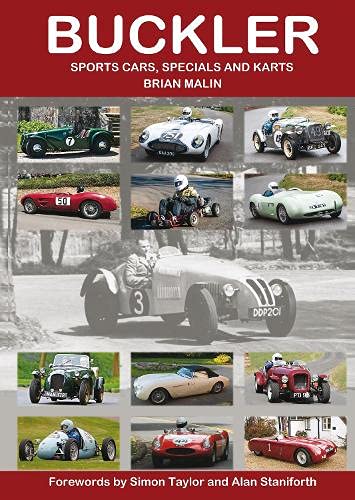
Although they were born 18 years apart, Derek Buckler and Colin Chapman were contemporaries when it came to designing and building ground-breaking sports cars in the late 1940s and early ’50s. They had much in common. Both were innovators, especially in areas of chassis design and improving the handling characteristics of their cars. Both founded successful companies and both died relatively young, Chapman in December, 1982, at the age of 54, and Buckler in 1964 at just 53 years of age. Yet, while Chapman’s Lotus went on to achieve worldwide fame, the name Buckler remains comparatively little known.
Special building was popular in the 1950s, mostly using ‘donor’ chassis from Austin 7 or Ford or simple ‘ladder’ frames but Buckler offered a multi-tubular space frame which was both stronger and lighter and, moreover, available in different models to suit different applications. He was also always ready to adapt his products to his customers’ requirements. In all of this, Buckler’s aim was to provide the impecunious enthusiast with a versatile sporting vehicle which could be used as daily transport during the week and, at weekends, in a wide range of motor sporting events from trials and driving tests to out and out racing. Often, however, the resulting Special would carry a name that concealed the Buckler contribution and a major part of the significance of Malin’s book and the vast amount of painstaking research put into it by its author is that much of that contribution is now revealed.
Buckler also, of course, made a range of complete cars starting with the versatile Mk5 and 6 and going on to encompass DD1 and DD2 with De Dion rear ends and the BB100 with backbone chassis introduced considerably before Lotus’s Elan and their other similarly based models. When karting became popular in the early 1960s, Buckler’s space frame technology found another application for which it was ideal and it became a major player in this burgeoning branch of motor sport. Buckler was also successful with its range of accessories including engine and transmission components and most notably its much admired close-ratio gears.
Brian Malin, the author, first owned a Buckler car in the 1970s and today competes in his Mk 5 in hill climbs and other events. He is an active member of the Buckler Register as well as the British Historic Kart Club and is often to be seen racing or demonstrating his Buckler kart so he is well placed to compile this comprehensive history of all things Buckler. It was first made available in loose-leaf form as long ago as 1990 but this is its first publication as a fully-fledged book, revised, updated and with additional material. Chassis design guru – and Buckler owner – the late Alan Staniforth provided the original foreword and this has been updated and included along with a new foreword by commentator and doyen of motor sport journalists, Simon Taylor.
The fourteen chapters begin with ‘Buckler and the Company’, cover the production and racing cars with some individual histories, the Buckler accessories including one chapter on the badges alone, overseas distribution – New Zealand was a particularly strong market for Buckler – and a fascinating section on the car advertisements before going on to cover the kart story in similar detail. The same number of appendices include reproductions of road tests, articles written by Derek Buckler, specifications of close-ratio gears and Buckler-tuned Ford engines, kart track tests and even one on Buckler letterheads. Malin’s work is truly encyclopaedic and therefore remarkable value for money not just as a reference on the Buckler marque but for its entertaining insight into the world of amateur motor sport of its time. The hundreds of illustrations range from reproductions of high quality contemporary and recent photographs to some admittedly lower quality originals, some of them obviously retouched to improve clarity, whose inclusion is well justified for their essential contribution to the Buckler story.
Brian Malin is to be congratulated for his perseverance in finally bringing to publication a book which is, to all intents and purposes, the full Buckler story.
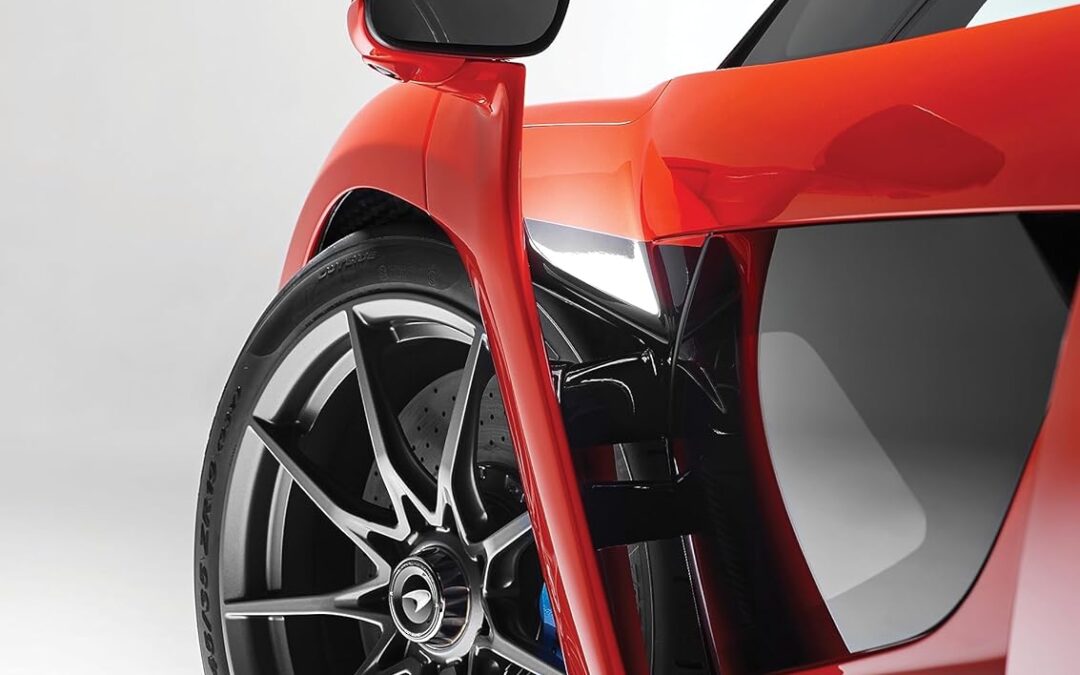
The definitive illustrated history of the exotic sports cars and supercars of McLaren Automotive.
When the McLaren Formula 1 team set up McLaren Cars and launched the revolutionary, iconic F1 road car in 1992, it turned the supercar world upside down. McLaren wouldn’t make another road car itself until it formed McLaren Automotive in 2010. It was set up with the vision not just to rival the established companies in the sports and supercar marketplace, but to disrupt and to constantly innovate in its pursuit of performance.
Readers will learn the following:
• Upstart company McLaren Automotive applied Formula 1 engineering expertise, innovation, and radical thinking to create cars that quickly became benchmarks for performance, ride, and handling against long-established supercar manufacturers such as Ferrari, Lamborghini, and Porsche.
• Unparalleled insight from the designers, engineers, aerodynamicists, and test drivers who create McLaren Automotive’s cars, with modern, independent insight from test drives by automotive journalists and the author
• Detailed technical insight, background stories, and data to the creation, development, and manufacture of all of McLaren Automotive’s sensational cars, with the text supported by comprehensive data tables and illustrated by images from a team of world-renowned automotive photographers
This book contains incredible insight and detail from access to McLaren’s press archives, as well as interviews with countless key people within the company. The first and only book dedicated entirely to McLaren’s incredible road cars, this is the complete history of a fascinating automotive brand that’s challenged the establishment.
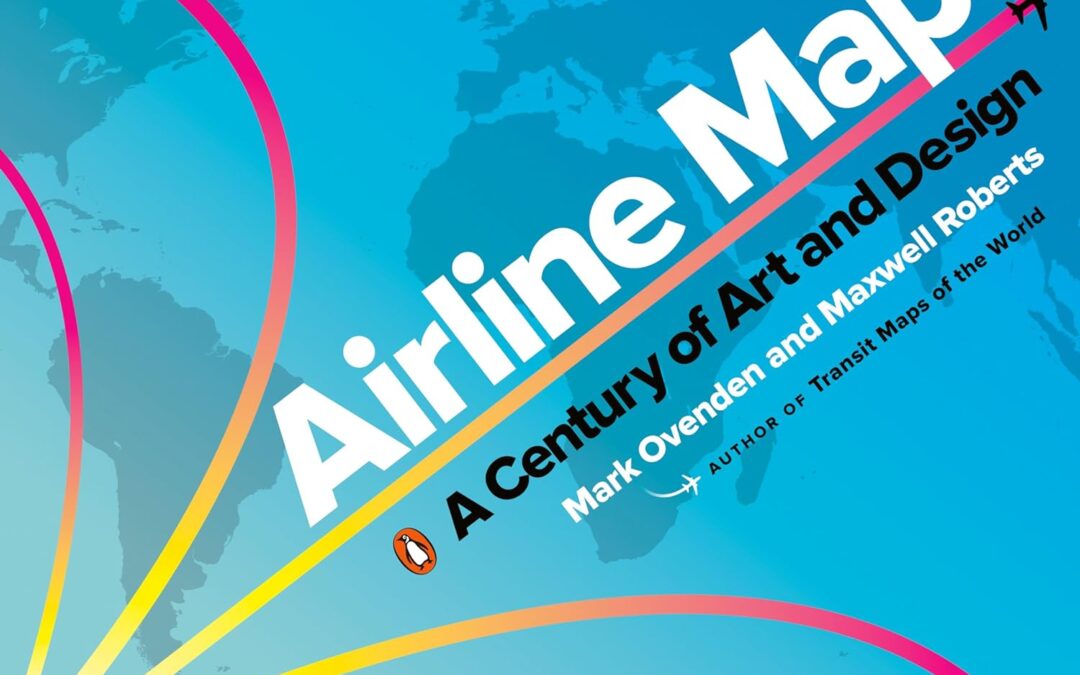
A nostalgic and celebratory look back at one hundred years of passenger flight, featuring full-color reproductions of route maps and posters from the world’s most iconic airlines, from the author of bestselling cult classic Transit Maps of the World.
In this gorgeously illustrated collection of airline route maps, Mark Ovenden and Maxwell Roberts look to the skies and transport readers to another time. Hundreds of images span a century of passenger flight, from the rudimentary trajectory of routes to the most intricately detailed birds-eye views of the land to be flown over. Advertisements for the first scheduled commercial passenger flights featured only a few destinations, with stunning views of the countryside and graphics of biplanes. As aviation took off, speed and mileage were trumpeted on bold posters featuring busy routes. Major airlines produced highly stylized illustrations of their global presence, establishing now-classic brands. With trendy and forward-looking designs, cartographers celebrated the coming together of different cultures and made the earth look ever smaller.
Eventually, fleets got bigger and routes multiplied, and graphic designers have found creative new ways to display huge amounts of information. Airline hubs bring their own cultural mark and advertise their plentiful destination options. Innovative maps depict our busy world with webs of overlapping routes and networks of low-cost city-to-city hopping. But though flying has become more commonplace, Ovenden and Roberts remind us that early air travel was a glamorous affair for good reason. Airline Maps is a celebration of graphic design, cartographic skills and clever marketing, and a visual feast that reminds us to enjoy the journey as much as the destination.
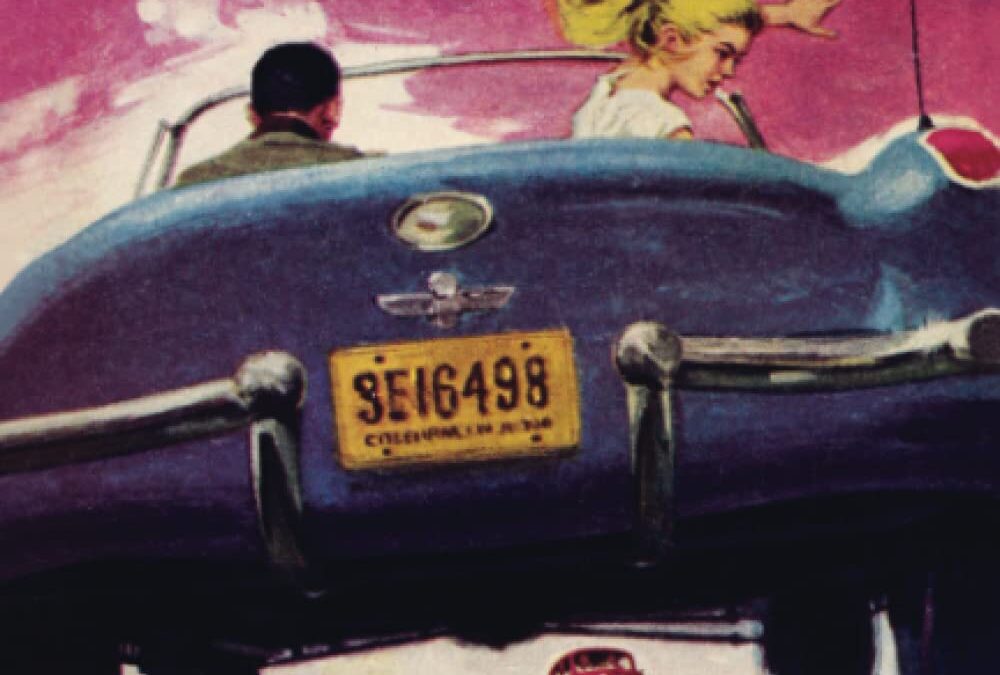
Every year a new fad makes its mark at Raccoon Forks High: often noisy, outlandish, expensive, or silly, but never dangerous or destructive. At this sleepy school, even the drag racing fad was comparatively tame . . . until David “Outlaw” Galt transferred from Capital City High. Usurping Mike Revere’s position as the best boy with the best car—and stealing the girl who went with it—Outlaw set off a power struggle the likes of which Raccoon Forks had never seen. But Mike was willing to drive his way to victory, no matter the cost.
Crash Club is another Felsen novel that captured the heart and soul of 1950s hot rod culture. The lean, mean story follows Revere’s hard-driving path to rodding redemption, riffs on some meaningful messages, and unleashes a fast and furious read. Dig in and learn what millions of readers already know; the world’s most popular hot rod novels are a hopped-up high-horsepower thrill ride.

Celebrate six decades of outrageous, unforgettable Lamborghini cars with this must-have volume featuring fascinating history and stunning photography.
Sixty years ago, Ferruccio Lamborghini put the sports car world on notice with the introduction of his V-12-powered 350 GT. Just three years later, in 1966, Lamborghini stunned the automotive establishment with its introduction of the stunning Miura, the first mid-engine production car. Rivals at the 1966 Geneva Auto Show could only stare in wonder. Wrapped in a svelte Marcello Gandini–penned body and powered by a 350-horsepower V-12, the Miura instantly made every other sports car look antiquated, including those offered by Lamborghini’s Italian rival, Ferrari. It would be two years before Ferrari offered its own mid-engine reply in the form of the 206 Dino GT.
For Lamborghini, there was the time before the Miura and the time after the Miura. It marked a sea change not only for the Sant’Agata manufacturer but for the sports car world broadly. The Supercar had arrived.
In 1974, Lamborghini again shocked the automotive world with the mad Countach (an Italian expression one might utter at the sight of a beautiful woman), another Gandini masterpiece. Wide, low, and purposeful, the Countach completely redefined the supercar template, in the process becoming the poster car of choice for children of all ages the world over.
As Supercars evolved to Hypercars, Audi acquired Lamborghini, giving new life to the firm and unleashing a series of amazing cars from the Murcielago to the Gallardo to the Aventador and Huracan. Today, there is even the all-purpose Urus SUV!
In this richly detailed survey spanning 60 years of extreme performance, each of Lamborghini’s seminal cars is detailed and complemented by historic and commissioned photography and technical specifications. Captivating to read and beautiful to behold, Lamborghini Supercars: 60 Years belongs in every sports-car fan’s collection.
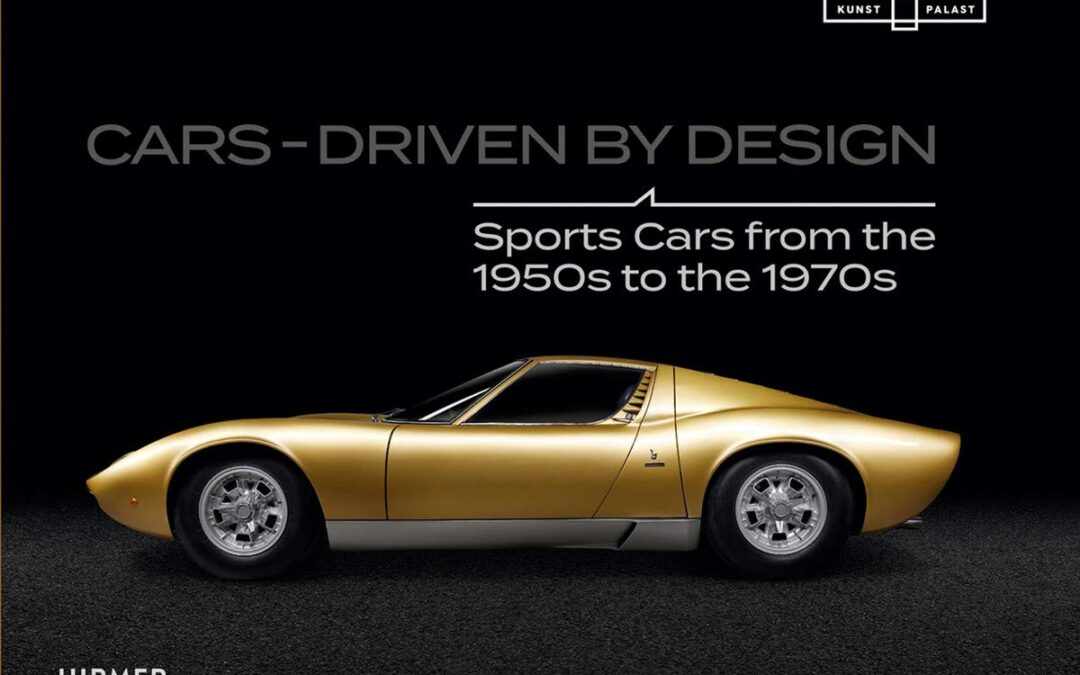
As a design object beyond its practical purpose, the automobile has left an indelible mark on the world we live in. There is scarcely another everyday item which has been designed in a more sophisticated and inventive manner and which offers a larger projection area. This can be seen with particular clarity in the sports car of the 1950s, ’60s, and ’70s, which are fast, beautiful, eccentric, and innovative. In recent decades, these coveted collector’s items have attained cult status, and have come to be widely regarded as dream cars for eternity. In an exciting journey through time, this volume pays homage to a selection of exclusive sports cars by legendary manufacturers—including Porsche, Ferrari, and Jaguar—showing them to be artworks in their own right. Essays, biographies, and brilliant color photographs shed light on the sports car’s unparalleled unity of form, technology, design, and emotions.
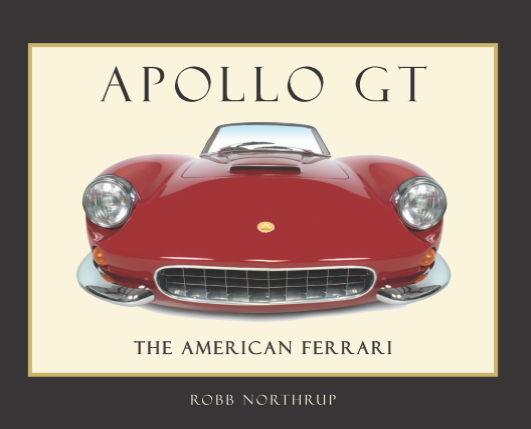
‘If a Buick Special ever got a fierce ambition to become a Ferrari – and tried hard enough – it would be likely to end up just about like this.”
Car and Driver magazine – September, 1963
Such prophetic words from Car and Driver magazine back in 1963 underscore the goal of three California twenty somethings who sought to build a world-class grand touring sports car. And, for a while, found themselves on equal ground with Europe’s best.
Their concept: A marriage of Italian style and the mechanical excellence of a premier American manufacturer – Buick – to create a true gran turismo sports car with head-turning looks, outstanding performance and comfort, and something that, up to then, was not common among European exotics: Reliability!
Their challenges were legion: A complex product combining hand-crafted bodies with mass-produced engines and transmissions on an assembly line spanning two continents and an ocean. A limited capability for product development and testing. And the need to create a marketing program to promote the car to an enthusiast public as well as develop a distribution channel to get the car into their hands. All this with limited operating capital.
The result? The Apollo was highly praised by both road testers and owners alike. “Workmanship is of the highest quality…comparable to cars costing twice that of the Apollo” crowed one magazine report. “…the Apollo handles as well or better than a 2+2 Ferrari, an Aston Martin DB4 or a Sting Ray Corvette,” exclaimed another. High praise indeed from the critical press!
And the owners? “I dearly love my Apollo!” enthused singer Pat Boone. And this from another owner: “It’s a wonderful work of art. You can see the quality. You can feel the excitement they felt when they were hammering it out, putting it together and driving it for the first time. It is a milestone, a one-of-a-kind car and no one can really compare anything to it. It stands on its own.”
This is the story of the Apollo GT. The American Ferrari.
Details: 8.5″ x 11″, 138 pages. 87 color and black & white photos and illustrations.











